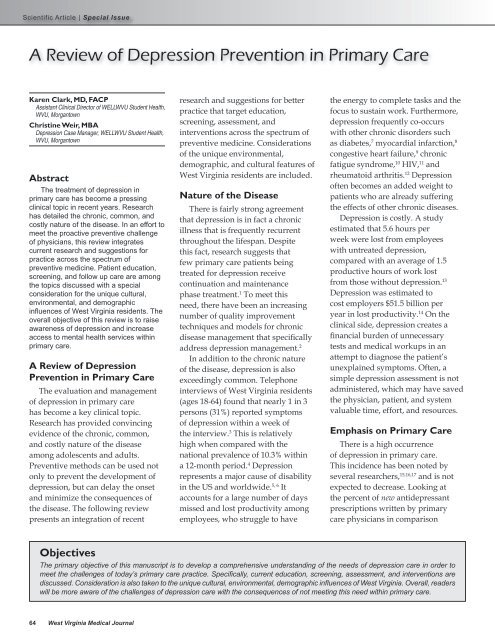Special CME Issue - West Virginia State Medical Association
Special CME Issue - West Virginia State Medical Association
Special CME Issue - West Virginia State Medical Association
Create successful ePaper yourself
Turn your PDF publications into a flip-book with our unique Google optimized e-Paper software.
A Review of Depression Prevention in Primary Care<br />
Karen Clark, MD, FACP<br />
Assistant Clinical Director of WELLWVU Student Health,<br />
WVU, Morgantown<br />
Christine Weir, MBA<br />
Depression Case Manager, WELLWVU Student Health,<br />
WVU, Morgantown<br />
Abstract<br />
The treatment of depression in<br />
primary care has become a pressing<br />
clinical topic in recent years. Research<br />
has detailed the chronic, common, and<br />
costly nature of the disease. In an effort to<br />
meet the proactive preventive challenge<br />
of physicians, this review integrates<br />
current research and suggestions for<br />
practice across the spectrum of<br />
preventive medicine. Patient education,<br />
screening, and follow up care are among<br />
the topics discussed with a special<br />
consideration for the unique cultural,<br />
environmental, and demographic<br />
influences of <strong>West</strong> <strong>Virginia</strong> residents. The<br />
overall objective of this review is to raise<br />
awareness of depression and increase<br />
access to mental health services within<br />
primary care.<br />
A Review of Depression<br />
Prevention in Primary Care<br />
The evaluation and management<br />
of depression in primary care<br />
has become a key clinical topic.<br />
Research has provided convincing<br />
evidence of the chronic, common,<br />
and costly nature of the disease<br />
among adolescents and adults.<br />
Preventive methods can be used not<br />
only to prevent the development of<br />
depression, but can delay the onset<br />
and minimize the consequences of<br />
the disease. The following review<br />
presents an integration of recent<br />
research and suggestions for better<br />
practice that target education,<br />
screening, assessment, and<br />
interventions across the spectrum of<br />
preventive medicine. Considerations<br />
of the unique environmental,<br />
demographic, and cultural features of<br />
<strong>West</strong> <strong>Virginia</strong> residents are included.<br />
Nature of the Disease<br />
There is fairly strong agreement<br />
that depression is in fact a chronic<br />
illness that is frequently recurrent<br />
throughout the lifespan. Despite<br />
this fact, research suggests that<br />
few primary care patients being<br />
treated for depression receive<br />
continuation and maintenance<br />
phase treatment. 1 To meet this<br />
need, there have been an increasing<br />
number of quality improvement<br />
techniques and models for chronic<br />
disease management that specifically<br />
address depression management. 2<br />
In addition to the chronic nature<br />
of the disease, depression is also<br />
exceedingly common. Telephone<br />
interviews of <strong>West</strong> <strong>Virginia</strong> residents<br />
(ages 18-64) found that nearly 1 in 3<br />
persons (31%) reported symptoms<br />
of depression within a week of<br />
the interview. 3 This is relatively<br />
high when compared with the<br />
national prevalence of 10.3% within<br />
a 12-month period. 4 Depression<br />
represents a major cause of disability<br />
in the US and worldwide. 5, 6 It<br />
accounts for a large number of days<br />
missed and lost productivity among<br />
employees, who struggle to have<br />
the energy to complete tasks and the<br />
focus to sustain work. Furthermore,<br />
depression frequently co-occurs<br />
with other chronic disorders such<br />
as diabetes, 7 myocardial infarction, 8<br />
congestive heart failure, 9 chronic<br />
fatigue syndrome, 10 HIV, 11 and<br />
rheumatoid arthritis. 12 Depression<br />
often becomes an added weight to<br />
patients who are already suffering<br />
the effects of other chronic diseases.<br />
Depression is costly. A study<br />
estimated that 5.6 hours per<br />
week were lost from employees<br />
with untreated depression,<br />
compared with an average of 1.5<br />
productive hours of work lost<br />
from those without depression. 13<br />
Depression was estimated to<br />
cost employers $51.5 billion per<br />
year in lost productivity. 14 On the<br />
clinical side, depression creates a<br />
financial burden of unnecessary<br />
tests and medical workups in an<br />
attempt to diagnose the patient’s<br />
unexplained symptoms. Often, a<br />
simple depression assessment is not<br />
administered, which may have saved<br />
the physician, patient, and system<br />
valuable time, effort, and resources.<br />
Emphasis on Primary Care<br />
There is a high occurrence<br />
of depression in primary care.<br />
This incidence has been noted by<br />
several researchers, 15,16,17 and is not<br />
expected to decrease. Looking at<br />
the percent of new antidepressant<br />
prescriptions written by primary<br />
care physicians in comparison<br />
Objectives<br />
The primary objective of this manuscript is to develop a comprehensive understanding of the needs of depression care in order to<br />
meet the challenges of today’s primary care practice. Specifically, current education, screening, assessment, and interventions are<br />
discussed. Consideration is also taken to the unique cultural, environmental, demographic influences of <strong>West</strong> <strong>Virginia</strong>. Overall, readers<br />
will be more aware of the challenges of depression care with the consequences of not meeting this need within primary care.<br />
64 <strong>West</strong> <strong>Virginia</strong> <strong>Medical</strong> Journal















